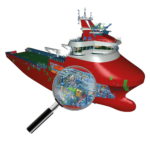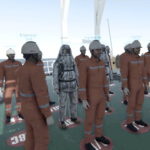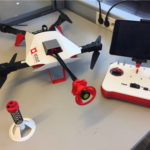What is the current position on the digital journey of the maritime industries? The 18th Conference on Computer and IT Applications in the Maritime Industries (COMPIT) will give an insight. An exclusive preview by organizer of Tutech Innovation
Over the past two decades, COMPIT has established itself as a key conference in information technology (IT) for the maritime[ds_preview] industries, bringing together software developers and users, designers and operators. The three-day conference is structured into 12 sessions. The main trends are:
Digital Twin splits and mutates: The Digital Twin grows and evolves as the real ship does. But he mutates along the way and often he dies (at the shipyard) and resurrects (at the ship owner). In essence, we adopt multi-facetted and multi-fidelity simulations to aid our decisions from the first concept to fleet in service. As long as we don’t know (or define strictly) what is a Digital Twin and what is not, not only marketing people (ab)use the term happily for anything that involves an engineering model or simulations. As a special application, designers like to review and communicate now in Virtual Reality, at least for the look, if not the feel.
Digital Training on the rise: Everybody hates e-Learning, everybody does e-Learning. But teething problems in digital training solutions are addressed and for a global and fragmented industry like ours, the reasonable advice seems to be: Resistance is futile – embrace digital (training).
Ship Operation 4.0: Long gone are the days where ship operators thought that having a PC for accounting and stock management meant they were computer-savvy and digital. Enter the world of Big Data and Artificial Intelligence (machine learning). Oh well, marketing storms it with flying color and grandiose claims. Mind the gap to current reality, but the few real applications shown merit attention. This does not just concern the »autonomous ship«, but also assorted applications for smarter operations, in energy saving and asset management.
The elusive Digital Twin
The Digital Twin is a much used (and abused) buzzword in the industry. The original vision was a 3d product data model, which mimics the behavior of the ship in a multitude of simulations and updates this behavior over the lifetime of the ship. The dream was to have a computer model with the look and feel of the real deal. Dreams die first.
As with Virtual Reality, the vision was much grander than the reality of current implementations. The life-cycle has been conveniently chopped up and we now hear »Design Digital Twin« or »Digital Twin for Operation«. And we have high-fidelity twins, and low-fidelity twins. (Maybe we are all low-fidelity twins of George Clooney?) The distinction between a simulation model and a specialized Digital Twin is no longer clear to me, but what’s in a name if the application is good? And there are many good applications, such as asset management. Tapio Hulkkonen (Napa) presents a textbook example in »Using Operational Fleet Intelligence Data together with 3D Product Model in Structure Analyses during Ship Life Cycle«. Here we have the original dream (3d model, finite-element simulations, and life-cycle tracking and updating from operational sensor data), even if »only« applied to the remaining fatigue life of ship structures. Royston Jones (Altair) combines two hot topics in his »The Development of the Intelligent Digital Twin for Autonomous Navigation Vessels«. Digital Twin meets Autonomous Ship. You have our attention, Mr. Jones!
Digital Twins in design may use the power of Virtual Reality. Chris Cassar et al. (UCL, BMT) show »The Implementation of Virtual Reality Software for Multidisciplinary Ship Design Revision« and Hans van der Tas (DEKC Maritime) reports positive experience on »Communicating Ship Designs via Virtual Reality«. A common theme is that VR can be a powerful communication tool, especially if 3d views (with zoom, turning and moving) are combined with product data model information and possibly simulations. Robert Spencer (Stirling Labs) sums it up: »The future of ship design will undoubtedly include Virtual Reality in some form, [but] deploying Virtual reality technology often requires rethinking workflows.«
Digital Twins play a leading role also in state-of-the-art energy efficient operation. In operation, hull performance monitoring is a prime example of using Digital Twin concepts. Myeong-Jo Son et al. (Korean Register) present a »Big Data Analysis Application: Brake Power and Fuel Oil Consumption Estimation based on Public History Voyage Data of Shipsq, merging AIS data and met-ocean data with simple hydrodynamic estimates based on public ship design data. Looking at 4,000 ships, they can identify typical and best-practice operational patterns as benchmarks for individual ship performance monitoring. But what happens when we bring the latest and greatest web technologies to the more traditional naval world? This provocative question is raised by Charles-Edouard Cady (Sirehna) in »Microservices to Reduce Ship Emissions«. The Digital Twin in the cloud combined with Big Data based performance monitoring can push operational guidance via an App to a captain’s mobile phone. But Cady sees also that »this approach creates challenges regarding certification, safety regulations, and security«.
Digital training on the rise
Blame it on Virtual Reality, but training is becoming a different game. Boosted by digital technologies we leave the known planet of nautical simulators, go where no [maritime] man has gone before and explore strange new worlds. For those feeling lost in this new universe, Volker Bertram and Tracy Plowman (DNV GL) offer »A Hitchhiker’s Guide to the Galaxy of Maritime e-Learning«. Behind the catchy title hides a rather differentiated view on digital training, explaining why most stakeholders are disenchanted: The key lies in unrealistic expectations. An important take-home message is that digital training is often (initially) costlier than you think. It may take 100 hours development time to get 1 hour of decent digital training.
The trend is towards combining digital training technologies, such as e-learning with simulation-based training. Michael Schmidt and Volker Köhler (benntec Systemtechnik) give a typical demonstration of how this is done in »Modular and Interactive Simulation Training Environment for Customer-Specific Maritime Training«. Raal Harris of market-leader KVH Videotel describes »How Virtual Reality Practically Impacts Learning Strategies within Maritime Training & Education«. He sees VR as potentially game-changing but points out that the digital transformation is not straightforward, but full of pitfalls and requiring re-designing training fundamentally. Woo-Sung Kil et al. present in »Development of Real-Time Emergency Response Training Simulator for Collective Ship Crews Based on Virtual and Mixed Reality« how Korean Register develops its Virtual Reality training tools presented at SMM 2018 further. The focus lies on safety training, such as fire drills or evacuation. Here, the technology has moved from single-player training to multi-player training, where also team coordination can be practiced in the virtual world.
Unmanned ships on the horizon
There is no escape from the discussion about unmanned shipping – also not at COMPIT. While unmanned transatlantic containerships are firmly rooted in the phantasy of artist visions, unmanned tugs and fireboats seem to be within reach technically, economically and legally. The development had matured to prototypes and detailed designs in several countries. Yan et al. (Wuhan University of Technology) work on a remotely controlled ferry crossing the busy Yangtze river. In »Applying the Navigation Brain System to Inland Ferries« they describe how advanced sensor technology and Artificial Intelligence are brought together to allow unmanned ferry operation. Laura Walther et al. (Fraunhofer) present German developments in »Shoreside Assistance for Remote-Controlled Tugs«. This assistance system ensures data transfer and communication with the tug, allows line handling and propulsion control and integrates a situational awareness system. For some, tugs may be small fry. So where is the unmanned cargo ship? In short, on the horizon as the session title indicates.
Svein-David Medhaug of the Norwegian Maritime Administration discusses unmanned shipping from an administration point of view, namely discussing the administration’s responsibility, and how the Norwegian administration will cope with innovation and new technologies. As an acknowledged pioneer in autonomous ship technology, Norway takes a leading role also in regulations and many will undoubtedly follow closely the disclosed roadmap and experience reported by the Norwegian administration. Medhaug prepares for a future where fully autonomous, partially autonomous and conventionally manned ships will operate side by side. Thomas Porathe (NTNU) takes a closer look at such scenarios from a perspective of occupational psychology. His paper advocates the need for precisions in the COLREGs and more transparency for the navigational plans of automated ships in the information exchange with conventionally manned ships.
The wider view
It is always difficult to pick highlights for the Hansa’s readership – too different at interests and professional backgrounds. But technology overviews and papers giving a perspective on an industry segment generally enjoy wider interest. Henrique Gaspar (NTNU) gives us »A perspective on past, present and future of computer-aided ship design«, where this rising superstar in the ship design scene reminds us of how many problems we have solved already – and how many new problems we created in the process. Fortunately, he remains optimistic for the future which will see »smart computer-aided systems in ship design, merging artificial intelligence [and simulation] models and open access to ship design data.« This seems to echo a wider sentiment in the industry. »There are many aspects in which Artificial Intelligence can be applied in ship design, [… e.g.] learning as you go through the design[s],« confirm Rodrigo Perez and Jesus Munoz (Sener) in their paper »A.I. technologies applied to naval CAD/CAM/CAE«, where they outline a medium-term vision for design and production in shipbuilding. Ludmilä Seppälä shares Cadmatic’s vision for a »Future of Drawing-less Production in Shipbuilding Projects«. Using foresight methods and input from CAD users and shipyards, Cadmatic has built probable future scenarios of shipbuilding production up to the year 2050. Alongside the paper explores the evolution of the role CAD played in the past and will play in the future of shipbuilding production.





















